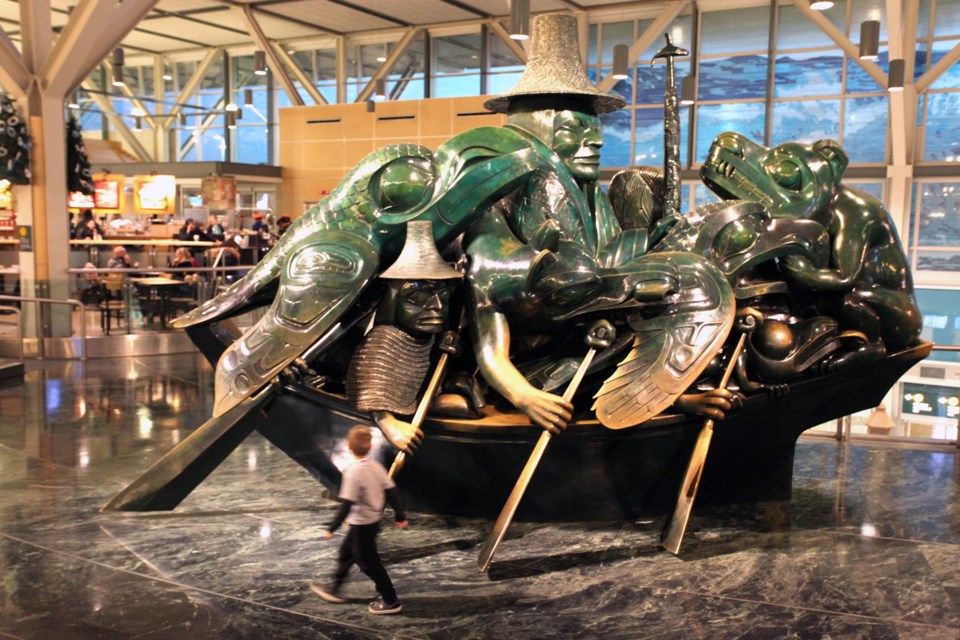Her cheeks still show signs of green but her nose is now the colour of polished bronze, thanks to travellers who rub it for good luck. Her name is the Mouse Woman: one of 13 mythological Haida figures aboard Bill Reid’s The Spirit of Haida Gwaii: The Jade Canoe at Vancouver International Airport.
Installed on April 18, 1996, the five-tonne sculpture is recognized as one of the most iconic pieces of public art in Canada. Twenty years after its arrival in the international terminal, the minibus-sized Jade Canoe still commands attention from passersby, if for nothing else than for its enormity.
Richmond artist Chris Charlebois said the artwork took many years to complete and Reid ultimately created a “timeless masterpiece.”
“Sometimes in an artist’s career everything comes together perfectly,” said Charlebois, a member of the city’s public art advisory committee. “It tells a story. But it also represents man’s connection with the spiritual. Where are we? Where are we going? Who is with us? How do we fit? There are many other questions to ask and this piece encourages us to think about them.”
Commissioned by the Vancouver International Airport Authority at a cost of $3 million, The Spirit of Haida Gwaii: The Jade Canoe was the second and final casting of Reid’s design. The first was completed in 1991 with a different finish and subtitle — The Black Canoe- — and put on display at the Canadian Embassy in Washington, DC.
The sculpture features a Grizzly Bear and the human Bear Mother in a crowded boat full of mythical creatures. Whatever their differences, they are paddling together — in one boat, in one direction.
The Jade Canoe, cast at an East Coast American foundry, spent the first several months of its life on display at the Museum of Anthropology and later Granville Island before being hoisted into the airport’s new terminal by crane.
Watching the artwork’s bronze pieces come together at YVR was 76-year-old Reid.
“Seated in a wheelchair, ailing in body but strong in mind, Bill Reid seemed to be the living embodiment of the journey depicted in his sculpture,” wrote Robin Laurence in her book A Sense of Place: Art at Vancouver International Airport. “As a high-profile artist of mixed Haida and German-American descent, Reid was an important bridge between cultures when non-Native people began to take notice of the indigenous art of the Northwest Coast in the middle of the 20th century.”
Reid died two years later. Today, much of the jade green patina that covers the bronze work has disappeared from the more accessible parts of the sculpture. Velvet ropes have never surrounded it, allowing travellers to get up close and personal with an artwork once featured on Canada’s $20 bill.
After the sculpture’s unveiling, a letter-writer complained the airport had created a “playground,” as children were climbing on something that deserved “more care and consideration.” The idea of viewers interacting with art was relatively new in Richmond at the time, when public art had little presence.
But the sculpture’s accessibility has only strengthened Reid’s legacy. The piece is said to have inspired the creation of the Vancouver Biennale — a bi-annual public art exhibition — and even after being the subject of countless photographs, The Jade Canoe is still turning heads at YVR.
Anne Murray, the airport’s vice-president of marketing and communications, said The Jade Canoe remains a focal point of the airport’s art collection, and “continues to command attention and admiration from YVR passengers, employees and visitors alike.”
It was the first major commissioned art piece for YVR — an airport that now houses one of the largest collections of B.C. First Nations art on public display.
“Along with the Musqueam Welcome Area, also commissioned for and installed in the international terminal building, (The Jade Canoe) has inspired YVR’s ongoing commitment to unite art and architecture as a means to create an award-winning sense of place,” said Murray in an e-mail.
No doubt the opening words of Reid’s accompanying poem still give travellers pause today: “Here we are at last, a long way from Haida Gwaii, not too sure where we are or where we’re going ...but somehow managing to appear to be heading in some direction.”



